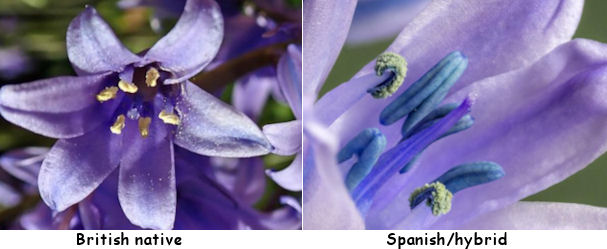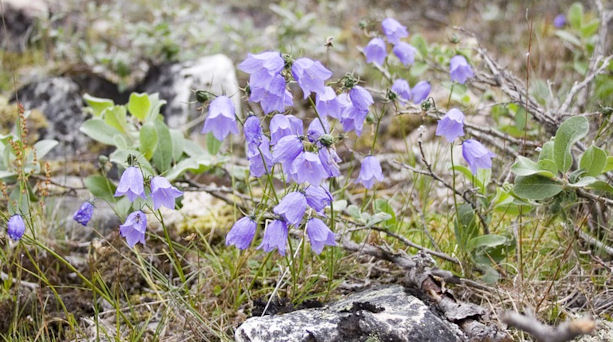English, Scottish and Spanish Bluebell
Everybody loves bluebells but UK readers beware. Our native bluebells are under threat, and not necessarily in the way you might think.

The British native bluebell is often referred to as the English bluebell to distinguish it from the Scottish bluebell, but more of that later. The true British native bluebell, Hyacinthoides non-scripta has always been thought of as a delicate underdog to the invasive and introduced Spanish bluebell Hyacinthoides hispanica and its easy to see why we might think that. Spanish bluebells have a wider habitat preference to our natives and they look a lot tougher, with broader, thicker leaves and they do spread like wildfire if allowed to. Both bluebells are able to hybridise naturally, resulting in a hybrid cross, Hyacinthoides x massartiana and it is this hybrid cross that is often mistaken for the true Spanish bluebell. The fact that the two species can hybridise, has led to fears our true natives will eventually become extinct due to hybridisation.
But our native bluebell is tougher than you think. Research published in 2019 concludes that our native bluebell is able to produce much more seed than either the Spanish or the hybrid species and this means our native will continue to dominate due to its ability to reproduce in greater numbers. That is, if they can cope with the threat from a far greater foe - human beings.
Every April, when the bluebells are in flower, we rush to capture their beauty and post our pictures all over social media. It's understandable - who couldn't resist sharing such a wonderful sight? However, thousands of bluebells are trampled in the process and that is the real threat. And then there's the threat to just about all our wildlife species in one way or another - climate change.

So, how do you know if the bluebells you have are true natives? Have a look inside the flower. The anthers (where the pollen is) of native bluebells are creamy white, whereas, the anthers of Spanish and hybrids are greeny-blue. Native bluebells have a distinctively sweet scent and the others have little or no scent.

The flowers on native bluebells are arranged on one side of the flower, giving it that recognisable 'nod' and the flowers of the Spanish and hybrids tend to be arranged all along the stem, on both sides. Finally, if it isn't blue, it's not a bluebell. Our native bluebells are nearly always blue. Occasionally, you get a natural mutation to white or pink but that's around 1 in every 10,000. You can buy cultivars, for example, Hyancinthiodes non-scripta 'Alba', but they've been bred by humans and they're not the true species.
If you happen to miss the bluebells in spring, you can always catch another bluebell - the Scottish bluebell - in summer. Scottish bluebells are actually harebells, Campanula rotundifolia and they're an entirely different genus altogether. In fact, they don't even belong to the same family. Scottish bluebells are in the campanula Campanulaceae family, whereas the English and Spanish are in the asparagus family. Even more confusing is the fact that Scottish bluebells can be seen in other parts of the UK and elsewhere in Europe. All of this is a good arguement for using Latin, not common names, to avoid confusion.

Campanula rotundifolia is a delicate little plant. Unlike Hyacinthoides non-scripta, it prefers open, grassy sites and can be found on exposed sites as well. It's probably happiest in poor, sandy soils and truly hates being damp. You'll find it in bloom in July, August and September.
Like all wild plants in the UK, Campanula rotundifolia is protected under the Wildlife and Countryside Act, making it an offence to uproot it without permission from the landowner but it also has another protector - the Devil himself. In Scottish folklore, it's considered to be the Devil's flower and bad luck to pick it.
Hyacinthoides non-scripta has even greater protection in law. It is one of few schedule 8 plants, making it illegal to sell wild bluebells without a license.
Unfortunately for Spanish bluebells living in Ireland, they still retain their reputation as thugs. They're listed as invasive in both the Republic of Ireland and Northern Ireland, making it an offence to plant or cause them to grow in the wild, though you can still have them in your garden.









